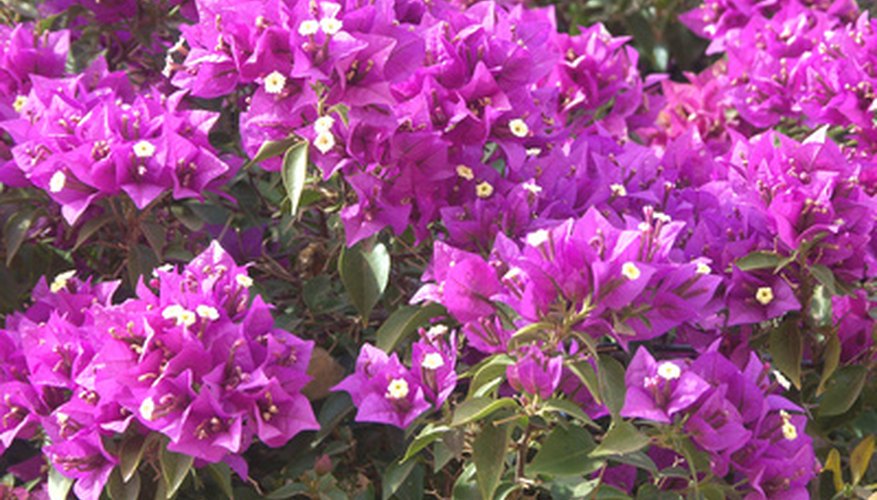Bougainvillea glabra is a member of the Nyctaginaceae family of tropical plants, and a species of bougainvillia. Native to Brazil, it has many adaptations that have enabled it to survive in the rainforest. Adaptation is a plant's way of evolving to fit its environment. For example, mesquite shrubs have roots that can go as deep as 75 feet to find water in desert sand. Bougainvillea glabra, which grows to a height and spread of 30 feet or more, has adapted to attract pollinators, protect itself from predators and climb to find light.
Leaves
Look closely at the flowers of bougainvillea glabra. You'll find they're tiny, waxy an white. What surrounds them in vibrant colour are specially adapted leaves, called bracts. Bracts are often confused as flower petals but they perform the same functions as the green leaves of the stems, with an added twist: their bright colour draws butterflies, bees and birds to the tiny flowers. Without them, the bougainvillea would have a much smaller chance at reproduction through cross-pollination.
- Look closely at the flowers of bougainvillea glabra.
- Bracts are often confused as flower petals but they perform the same functions as the green leaves of the stems, with an added twist: their bright colour draws butterflies, bees and birds to the tiny flowers.
Flowers
Observe the tiny flowers of bougainvillea glabra. They are adapted to have a sweet scent; another attractor for pollinators. Once the flower is pollinated, small, narrow, five-lobed fruits form. Because both flowers and fruit have adapted to be small and inconspicuous among the colourful bracts, they have a better chance of developing through the fruit stage where seeds grow. The fruits become brittle and break open, dispersing the seed and continuing the life cycle.
- Observe the tiny flowers of bougainvillea glabra.
- Because both flowers and fruit have adapted to be small and inconspicuous among the colourful bracts, they have a better chance of developing through the fruit stage where seeds grow.
Stems
Examine the stem of a mature bougainvillea glabra. It's up to 9 inches in diameter, woody, and very tough. It needs to be, to support the spreading, vinelike canopy as it spreads in every direction. The stems of bougainvillea glabra are adapted for climbing distances in the rainforest to find light. For this reason, the stems of bougainvillea can be trained to climb trellises and arbors. Be careful though. Another adaptation of the stems is rigid, pointed thorns, which evolved to prevent grazing animals from chewing on them.
- Examine the stem of a mature bougainvillea glabra.
- The stems of bougainvillea glabra are adapted for climbing distances in the rainforest to find light.
Roots
Look at the root ball of a bougainvillea glabra at the nursery. You'll notice it's small, compared to the root ball of other shrubs of similar size. The roots of bougainvillea, like many rainforest plants, are adapted for wet soils where water is easily accessible. For this reason, the roots will tend to spread laterally at shallow depth instead of plunging straight down.
- Look at the root ball of a bougainvillea glabra at the nursery.
- The roots of bougainvillea, like many rainforest plants, are adapted for wet soils where water is easily accessible.
